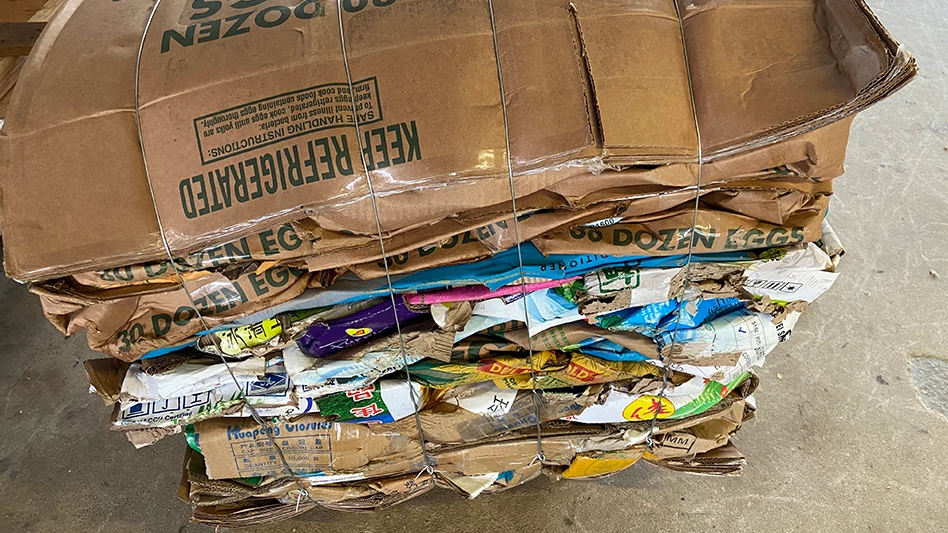.jpg) Today’s bargain-basement ferrous scrap prices are weighing heavily upon the demolition sector, which historically has financed or subsidized the cost of demolition projects with the proceeds from scrap sales.
Today’s bargain-basement ferrous scrap prices are weighing heavily upon the demolition sector, which historically has financed or subsidized the cost of demolition projects with the proceeds from scrap sales.
The swiftest blow yet came in October, when prices on Pittsburgh-based Management Science Associates’ Raw Material Data Aggregation Service (RMDAS) ferrous scrap index registered $167 (U.S. average) for No. 1 heavy melting steel (HMS), reflecting the nearly 50 percent price decline the grade has faced during 2015.
Demolition company managers say the lower scrap prices will require building owners to foot more of the demolition costs—the portion that would have, or should have, been covered by the sale of scrap metal. They also say there’s no escaping the impacts these price drops are having on the market, which can make for some difficult business decisions.
Difficult decisions
Brian Baumann, president of B&B Wrecking, based in Cleveland, describes strong construction activity in his company’s service areas, a six-state region that comprises Ohio and neighboring states. This market strength is evident despite the ferrous scrap downturn, says Baumann, who serves as a board member of the Washington-based National Demolition Association (NDA).
“Cleveland, especially, has a lot of investments going on as it’s gearing up for the Republican National Convention next July,” Baumann observes.
Along with that strong construction market is a decent amount of demolition work, Baumann says. Even so, declining scrap prices this year have become increasingly difficult to deal with.
“It’s really devastating for a lot of the jobs,” he says, “especially if you bid them six to eight months ago, and now you’ve lost over $100 a ton on that material.”
He says as much as 30 to 40 percent of the company’s revenue from demolition work has historically come from scrap metal, which typically comprises ferrous plate and structural materials, shreddables, rebar and nonferrous scrap, which also has faced its own declines this year. That means a job representing 500 tons of scrap to B&B now brings in about $50,000 less in revenue than it would have earlier this year or last year.
“It’s a huge part of our revenues, and when you take that and cut it in half, you’ve got to charge more for the work you’re doing.” This means owners might be asked to pay for a bigger part of the demolition costs to help make up the difference. But raising prices can be a difficult proposition when owners were previously quoted or are accustomed to having demolition work done for so much per square foot, Baumann explains. When those price increases are presented, he says, owners can have a tendency to question them, citing today’s lower diesel fuel prices as one justification that demolition costs should instead be going the other way.
To those arguments, Baumann says, “I tell people and owners, ‘I’d gladly pay $5 a gallon for diesel fuel if you give me $400 per ton for scrap again.’”
However, Baumann says while owners and developers are to some extent realizing they need more money in the budget, raising prices hasn’t always been a foregone conclusion. “A lot of the jobs, you live with the market going down and take the job anyway,” he says. In some cases, demolition contractors may have opted to do the work to keep the flow of work moving.
“That comes down to a business decision if you want to do the job for less margin or not, and those choices are sometimes difficult,” he says.
Even though quotes are typically valid only for 30 days, Baumann says demolition contractors risk losing crucial work when previously quoted contracts aren’t honored or are turned away, which is something he’s done only twice. Another option is charging owners a higher price based on the loss in scrap value.
“Some owners will entertain that, while others will say, ‘That’s not acceptable, and I’m not going to work with your firm,’ and they will go to someone else,” Baumann cautions.
Making the situation even more difficult for scrap contractors is that demolition projects can be delayed for any number of reasons that aren’t related to scrap revenue. Financing issues, asbestos abatement or permitting holdups are all factors that can delay work and hence affect profitability on previously quoted jobs. “Nothing happens fast,” Baumann says.
Of course, the declining value of the scrap in a project also can be the reason an owner decides to delay. With that in mind, Baumann says today’s lower prices may have led to a recent slowdown he’s witnessed in the commercial and industrial projects sector. Baumann estimates the true demand for demolition work in his markets to be as much as 15 percent higher than what he’s actually seeing, particularly among large industrial accounts, because of the loss in scrap values. As an example, he refers to some larger utility projects he’s aware of, involving as much as 20,000 tons of scrap, that are now mothballed waiting for better market prices.
Unusual conditions
Demolition contractors say today’s bearish market is unlike others faced in the past because scrap prices dropped this year almost without warning.
“There has never been this sharp of a decline this quickly,” Baumann says, describing how steel scrap prices seemed stable at around the $400 range from 2010 through 2014.
“Everyone was taking down buildings just to get the scrap because there was enough money in it to pay for the demolition,” he says of those years.
But in February of 2015, he says, “the market dropped $100 out of the blue.”
Leonard Cherry, president of Houston-based Cherry Cos., also describes this year’s scrap price declines as unusually strong. “It’s unusual to see scrap as low as it is today,” he observes.
As do many others, the demolition services company is able to help balance the ebb and flow of scrap prices with revenue from its other recycling streams: concrete, asphalt, shingles and tires.
Being based in a part of the country largely affected by the gas and oil industries, Cherry claims that scrap metal prices tend to mirror oil prices historically, but he admits that current price curves aren’t following what he says has been a 30-year trend.
“Surprisingly, over these last 60 days, those scrap price trends have dropped significantly below the trend of a barrel of oil,” he says. “We could all anticipate scrap dropping, then when we see oil prices stabilizing, you expect to see the same with scrap stabilizing.”
Cherry attributes at least some of this volatility to the strength of the U.S. dollar, which ends up putting pressure on domestic steel mill costs.
Similarly, Baumann blames the declining trend on such factors as the strong U.S. dollar, which makes U.S. exports expensive; China’s currency devaluation in August; and oil prices around $50 per barrel that brought U.S. oil and gas industry investments to a standstill.
Cherry says he believes the drop in scrap prices certainly has suppressed demand for demolition work throughout the industry as a whole as a number of projects have been put on hold for those customers that can afford to wait.
“That primarily hits us in the demolition industry and industrial sector and secondarily in the commercial sector,” he says, referring to the company’s recycling business. “The bottom has fallen out of the scrap market, and we certainly didn’t anticipate the numbers to dip as low as they are today.”
However, it’s not all bad news. In Texas, Cherry says while the demolition sector is continuing to cool, “my understanding is there are other areas within the U.S. that the markets are continuing to be strong,” he adds. One of those might be the Northeast, Cherry says, where federal and state tax dollars are being used to reinvest in communities.
While those type of stimulus programs were evident in Texas after the 2008 downturn, Cherry says, they seem to be largely nonexistent in the area now.
“The one upside potential we have [is that] we are beginning the process to reinvest in road construction, which is severely needed in Texas due to continuing population growth,” he says. Cherry says his company will benefit from road and bridge removal on the demolition side and from recycling the aggregate from that work.
Employing countermeasures
Recyclers have a number of ways they’ve attempted to address the scrap pricing situation to help preserve margins or cut losses. Cherry says, while his business doesn’t double-handle scrap, the company has been inventorying its processed rebar since early September.
Meanwhile, Rich Lorenz, president and CEO of Central Environmental Services, Apopka, Florida, observes that though scrap metal prices are reaching 12- or 13-year lows, there’s not much his company or others in the business can do.
“The demolition contractor has no say but continues to recycle at an enormous rate,” he says. “Demolition contractors are known for their uncanny ability to recycle, and on average, many of us can recycle 80 to 85 percent of every building we wreck. It’s part of our persona and our reputation,” says the industry veteran who served as a member of the NDA’s board of directors for some 21 years.
Lorenz also says the downturn in scrap values has influenced the 52-year-old family-run business to begin picking up more cardboard, now worth almost $200 per ton in the area. The full-service recycling company operates a 44,000-square-foot recycling center and produces 62 different products. As another strategy, Lorenz says, the company is holding on to copper now, hoping for the opportunity to fill the occasional spot order at a premium price.
“It’s turned into a very, very competitive situation,” he says.
Silver linings
Even with today’s difficult conditions for demolition contractors, Lorenz says his company, located in central Florida, is not short of work and continues to be sought out by contractors seeking LEED (Leadership in Energy & Environmental Design) points from the U.S. Green Building Council on their high-end and often time-sensitive projects. The company has done quite a bit of work for the area’s theme parks, he says, and it doesn’t hurt that the area leads the nation in terms of construction activity, he says.
Meanwhile, Baumann says the bids he is preparing today include very little revenue from scrap, considering it is worth barely more than $100 per gross ton compared with $400 and $500 just a few years ago. And while B&B’s performance over the last two years has allowed the company to purchase new equipment, Baumann says he expects his company’s 2015 gross sales to be down by 20 to 25 percent from 2014, making equipment investments more of a pipe dream for the time being.
“This year, I don’t see us doing any of that. There’s not a lot of positive outlook for expansion of the demolition market,” he says.
However, Cherry notes that, being in the business for 63 years, his company has ridden these cyclical markets before.
“The work is not coming to an end. Business is cyclical and, unfortunately, we’re headed in our region into a lower cycle,” he says.
“It’s not the first time we’ve been through a downturn cycle, and it won’t be the last.”
The author is a managing editor with the Recycling Today Media Group and can be reached at lmckenna@gie.net.

Explore the December 2015 Issue
Check out more from this issue and find your next story to read.
Latest from Recycling Today
- Acerinox names new North American Stainless CEO
- Greenwave closes 2024 books with red ink
- Steel Dynamics nets $217M on record shipments
- Massive Chinese steelmaking rebound recorded in March
- LME looks into sustainable metal pricing
- OnePlanet Solar Recycling closes $7M seed financing round
- AMCS launches AMCS Platform Spring 2025 update
- Cyclic Materials to build rare earth recycling facility in Mesa, Arizona





